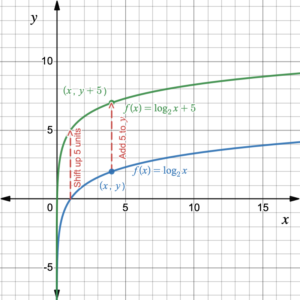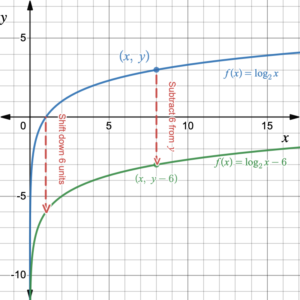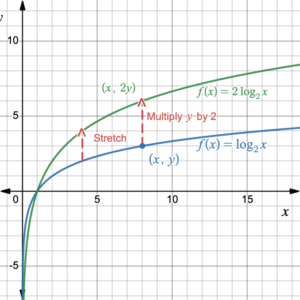Learning Objectives
For the logarithmic function [latex]f(x)=\log_b{x}[/latex],
- Perform vertical and horizontal shifts
- Perform vertical compressions and stretches
- Perform reflections across the [latex]x[/latex]-axis
- Perform reflections across the [latex]y[/latex]-axis
- Determine the transformations of the logarithmic function [latex]f(x)=a\log_b{(x-h)}+k[/latex]
- Determine the equation of a function given the transformations
- Determine what happens to the vertical asymptote as transformations are made
Vertical Shifts
If we shift the graph of the logarithmic function [latex]f(x)=\log_2{x}[/latex] up 5 units, all of the points on the graph increase their [latex]y[/latex]-coordinates by 5, but their [latex]x[/latex]-coordinates remain the same. Therefore, the equation of the function [latex]f(x)=\log_2{x}[/latex] after it has been shifted up 5 units transforms to [latex]f(x)=\log_2{x}+5[/latex]. The vertical asymptote at [latex]x=0[/latex] remains the same. Table 1 shows the changes to specific values of this function, which are replicated on the graph in figure 1.
| [latex]x[/latex] | [latex]\log_2{x}[/latex] | [latex]\log_2{x}+5[/latex] |
Figure 1. Shifting the graph of [latex]f(x)=\log_2{x}[/latex] up 5 units. |
|---|---|---|---|
| [latex]\dfrac{1}{8}[/latex] | [latex]-3[/latex] | [latex]2[/latex] | |
| [latex]\dfrac{1}{4}[/latex] | [latex]-2[/latex] | [latex]3[/latex] | |
| [latex]\dfrac{1}{2}[/latex] | [latex]-1[/latex] | [latex]4[/latex] | |
| [latex]1[/latex] | [latex]0[/latex] | [latex]5[/latex] | |
| [latex]2[/latex] | [latex]1[/latex] | [latex]6[/latex] | |
| [latex]4[/latex] | [latex]2[/latex] | [latex]7[/latex] | |
| [latex]8[/latex] | [latex]3[/latex] | [latex]8[/latex] | |
| Table 1. [latex]f(x)=\log_2{x}[/latex] is transformed to [latex]f(x)=\log_2{x}+5[/latex]. | |||
If we shift the graph of the function [latex]f(x)=\log_2{x}[/latex] down 6 units, all of the points on the graph decrease their [latex]y[/latex]-coordinates by 6, but their [latex]x[/latex]-coordinates remain the same. Therefore, the equation of the function [latex]f(x)=\log_2{x}[/latex] after it has been shifted down 6 units transforms to [latex]f(x)=\log_2{x}-6[/latex].The vertical asymptote at [latex]x=0[/latex] remains the same. Table 2 shows the changes to specific values of this function, which are replicated on the graph in figure 2.
| [latex]x[/latex] | [latex]\log_2{x}[/latex] | [latex]\log_2{x}-6[/latex] |
Figure 2. Shifting the graph of [latex]f(x)=\log_2{x}[/latex] down 6 units. |
|---|---|---|---|
| [latex]\dfrac{1}{8}[/latex] | [latex]-3[/latex] | [latex]-9[/latex] | |
| [latex]\dfrac{1}{4}[/latex] | [latex]-2[/latex] | [latex]-8[/latex] | |
| [latex]\dfrac{1}{2}[/latex] | [latex]-1[/latex] | [latex]-7[/latex] | |
| [latex]1[/latex] | [latex]0[/latex] | [latex]-6[/latex] | |
| [latex]2[/latex] | [latex]1[/latex] | [latex]-5[/latex] | |
| [latex]4[/latex] | [latex]2[/latex] | [latex]-4[/latex] | |
| [latex]8[/latex] | [latex]3[/latex] | [latex]-3[/latex] | |
| Table 2. [latex]f(x)=\log_2{x}[/latex] is transformed to [latex]f(x)=\log_2{x}-6[/latex]. | |||
Notice that vertical shifts up or down do not change the vertical asymptote.
Move the red dots in manipulation 1 to change the values of [latex]b[/latex] and [latex]k[/latex]. Pay attention to what happens to the graph and the relationship between the value of [latex]k[/latex] and the transformed function.
Manipulation 1. Vertical shifts
Vertical shifts
We can represent a vertical shift of the graph of [latex]f(x)=\log_2{x}[/latex] by adding or subtracting a constant, [latex]k[/latex], to the function:
[latex]f(x)=\log_2{x}+k[/latex]
If [latex]k>0[/latex], the graph shifts upwards and if [latex]k<0[/latex] the graph shifts downwards.
Example 1
- If [latex]f(x)=\log_3x[/latex] is shifted vertically up by 7 units, what is the equation of the transformed function?
- If [latex]f(x)=\log_7x[/latex] is shifted vertically down by 4 units, what is the equation of the transformed function?
- What transformation was made to the parent function [latex]f(x)=\log_5x[/latex] if the transformed function is [latex]f(x)=\log_5x+9[/latex]?
- What transformation was made to the parent function [latex]f(x)=\log_2x[/latex] if the transformed function is [latex]f(x)=\log_2x-3[/latex]?
Solution
With vertical shifts, the parent function [latex]f(x)=\log_bx[/latex] is transformed to [latex]f(x)=\log_bx+k[/latex].
- [latex]k=7[/latex] so the transformed function is [latex]f(x)=\log_3x+7[/latex]
- [latex]k=-4[/latex] so the transformed function is [latex]f(x)=\log_7x-4[/latex]
- [latex]k=9[/latex] so the transformation was a vertical shift up by 9 units.
- [latex]k=-3[/latex] so the transformation was a vertical shift down by 3 units.
Try It 1
- If [latex]f(x)=\log_3x[/latex] is shifted vertically up by 2 units, what is the equation of the transformed function?
- If [latex]f(x)=\log_7x[/latex] is shifted vertically down by 9 units, what is the equation of the transformed function?
- What transformation was made to the parent function [latex]f(x)=\log_5x[/latex] if the transformed function is [latex]f(x)=\log_5x+3[/latex]?
- What transformation was made to the parent function [latex]f(x)=\log_2x[/latex] if the transformed function is [latex]f(x)=\log_2x-8[/latex]?
Horizontal Shifts
If we shift the graph of the function [latex]f(x)=\log_2{x}[/latex] right 8 units, all of the points on the graph increase their [latex]x[/latex]-coordinates by 8, but their [latex]y[/latex]-coordinates remain the same. The [latex]x[/latex]-intercept (1, 0) in the original graph is moved to (9, 0) (figure 3). The vertical asymptote at [latex]x=0[/latex] shifts right by 8 units to [latex]x=8[/latex]. Any point [latex](x, y)[/latex] on the original graph is moved to [latex](x+8, y)[/latex].
But what happens to the original function [latex]f(x)=\log_2{x}[/latex]? An automatic assumption may be that since [latex]x[/latex] moves to [latex]x+8[/latex] that the function will become [latex]f(x)=\log_2{(x+8)}[/latex]. But that is NOT the case. Remember that the [latex]x[/latex]-intercept is moved to (9, 0) and if we substitute [latex]x=9[/latex] into the function [latex]f(x)=\log_2{(x+8)}[/latex] we get [latex]f(9)=\log_2{(9+8)}=4.0875 \neq 1[/latex]!! The way to get a function value of 0 is for the transformed function to be [latex]f(x)=\log_2{(x-8)}[/latex]. Then [latex]f(9)=\log_2{(9-8)}=0[/latex]. So the function [latex]f(x)=\log_2{x}[/latex] transforms to [latex]f(x)=\log_2{(x-8)}[/latex] after being shifted 8 units to the right. The reason is that when we move the function 8 units to the right, the [latex]x[/latex]-value increases by 8 and to keep the corresponding [latex]y[/latex]-coordinate the same in the transformed function, the [latex]x[/latex]-coordinate of the transformed function needs to subtract 8 to get back to the original [latex]x[/latex] that is associated with the original [latex]y[/latex]-value. Table 3 shows the changes to specific values of this function, and the graph is shown in figure 3.
| [latex]x[/latex] | [latex]x-8[/latex] | [latex]\log_2{(x-8)}[/latex] |
Figure 3. Shifting the graph right 8 units. |
|---|---|---|---|
| [latex]\dfrac{65}{8}[/latex] | [latex]\dfrac{1}{8}[/latex] | [latex]-3[/latex] | |
| [latex]\dfrac{33}{4}[/latex] | [latex]\dfrac{1}{4}[/latex] | [latex]-2[/latex] | |
| [latex]\dfrac{17}{2}[/latex] | [latex]\dfrac{1}{2}[/latex] | [latex]-1[/latex] | |
| [latex]9[/latex] | [latex]1[/latex] | [latex]0[/latex] | |
| [latex]10[/latex] | [latex]2[/latex] | [latex]1[/latex] | |
| [latex]12[/latex] | [latex]4[/latex] | [latex]2[/latex] | |
| [latex]16[/latex] | [latex]8[/latex] | [latex]3[/latex] | |
| Table 3. Shifting the graph right by 8 units transforms [latex]f(x)=\log_2{x}[/latex] into [latex]f(x)=\log_2{(x-8)}[/latex]. | |||
Notice that the vertical asymptote also shifts from [latex]x=0[/latex] to [latex]x=8[/latex].
On the other hand, if we shift the graph of the function [latex]f(x)=\log_2{x}[/latex] left by 11 units, all of the points on the graph decrease their [latex]x[/latex]-coordinates by 11, but their [latex]y[/latex]-coordinates remain the same. So any point [latex](x, y)[/latex] on the original graph moves to [latex](x-11, y)[/latex]. Consequently, to keep the same [latex]y[/latex]-values we need to increase the [latex]x[/latex]-value by 11 in the transformed function. The equation of the function after being shifted left 11 units is [latex]f(x)=\log_2{(x+11)}[/latex]. Table 4 shows the changes to specific values of this function, and the graph is shown in figure 4.
| [latex]x[/latex] | [latex]x+11[/latex] | [latex]f(x)=\log_2{(x+11)}[/latex] |
Figure 4. Shifting the graph left 11 units. |
|---|---|---|---|
| [latex]-\dfrac{87}{8}[/latex] | [latex]\dfrac{1}{8}[/latex] | –3 | |
| [latex]-\dfrac{43}{4}[/latex] | [latex]\dfrac{1}{4}[/latex] | –2 | |
| [latex]-\dfrac{21}{2}[/latex] | [latex]\dfrac{1}{2}[/latex] | –1 | |
| –10 | 1 | 0 | |
| –9 | 2 | 1 | |
| –7 | 4 | 2 | |
| –3 | 8 | 3 | |
| Table 4. Shifting the graph left by 11 units transforms [latex]f(x)=\log_2{x}[/latex] into [latex]f(x)=\log_2{(x+11)}[/latex]. | |||
Notice that the vertical asymptote also shifts from [latex]x=0[/latex] to [latex]x=-11[/latex].
Move the red dots in manipulation 2 to change the values of [latex]b[/latex] and [latex]h[/latex]. Pay attention to what happens to the graph and the relationship between the value of [latex]h[/latex] and the transformed function.
Manipulation 2. Horizontal shifts
horizontal shifts
We can represent a horizontal shift of the graph of [latex]f(x)=\log_2{x}[/latex] by adding or subtracting a constant, [latex]h[/latex], to the variable [latex]x[/latex].
[latex]f(x)=\log_2{(x}-h)[/latex]
If [latex]h>0[/latex] the graph shifts toward the right and if [latex]h<0[/latex] the graph shifts to the left. The vertical asymptote [latex]x=0[/latex] shifts to [latex]x=h[/latex].
Example 2
- If [latex]f(x)=\log_3x[/latex] is shifted right by 2 units, what is the equation of the transformed function?
- If [latex]f(x)=\log_7x[/latex] is shifted left by 9 units, what is the equation of the transformed function?
- What transformation was made to the parent function [latex]f(x)=\log_5x[/latex] if the transformed function is [latex]f(x)=\log_5{(x+3)}[/latex]?
- What transformation was made to the parent function [latex]f(x)=\log_2x[/latex] if the transformed function is [latex]f(x)=\log_2{(x-8)}[/latex]?
Solution
With horizontal shifts, the parent function [latex]f(x)=\log_bx[/latex] is transformed to [latex]f(x)=\log_b{(x-h)}[/latex].
- [latex]h=2[/latex] so the transformed function is [latex]f(x)=\log_3{(x-2)}[/latex]
- [latex]h=-9[/latex] so the transformed function is [latex]f(x)=\log_7{(x+9)}[/latex]
- [latex]h=-3[/latex] so the transformation was a horizontal shift left by 3 units.
- [latex]h=8[/latex] so the transformation was a horizontal shift right by 8 units
Try It 2
- If [latex]f(x)=\log_3x[/latex] is shifted right by 7 units, what is the equation of the transformed function?
- If [latex]f(x)=\log_7x[/latex] is shifted left by 4 units, what is the equation of the transformed function?
- What transformation was made to the parent function [latex]f(x)=\log_5x[/latex] if the transformed function is [latex]f(x)=\log_5{(x-5)}[/latex]?
- What transformation was made to the parent function [latex]f(x)=\log_2x[/latex] if the transformed function is [latex]f(x)=\log_2{(x+4)}[/latex]?
We can combine vertical and horizontal shifts by transforming [latex]f(x)=\log_b{(x-h)}+k[/latex].
Move the red dots in manipulation 3 to change the values of [latex]b, \;h[/latex] and [latex]k[/latex]. Pay attention to what happens to the graph and the relationship between the values of [latex]h[/latex] and[latex]h[/latex] and the transformed function.
Manipulation 3. Vertical and horizontal shifts
Example 3
- If [latex]f(x)=\log_3x[/latex] is shifted vertically down by 3 units and right by 2 units, what is the equation of the transformed function?
- If [latex]f(x)=\log_7x[/latex] is shifted left by 9 units and up by 6 units, what is the equation of the transformed function?
- What transformation was made to the parent function [latex]f(x)=\log_5x[/latex] if the transformed function is [latex]f(x)=\log_5{(x-2)}+7[/latex]?
- What transformation was made to the parent function [latex]f(x)=\log_2x[/latex] if the transformed function is [latex]f(x)=\log_2{(x+5)}-4[/latex]?
Solution
With horizontal and vertical shifts, the parent function [latex]f(x)=\log_bx[/latex] is transformed to [latex]f(x)=\log_b{(x-h)}+k[/latex].
- [latex]h=2,\;k=-3[/latex] so the transformed function is [latex]f(x)=\log_3{(x-2)}-3[/latex]
- [latex]h=-9,\;k=6[/latex] so the transformed function is [latex]f(x)=\log_7{(x+9)}+6[/latex]
- [latex]h=2,\;k=7[/latex] so the transformation was a horizontal shift right by 2 units and up by 7 units.
- [latex]h=-5,\;k=-4[/latex] so the transformation was a horizontal shift left by 5 units and down by 4 units.
Try It 3
- If [latex]f(x)=\log_3x[/latex] is shifted down by 7 units and right by 5 units, what is the equation of the transformed function?
- If [latex]f(x)=\log_7x[/latex] is shifted left by 4 units and up by 3 units, what is the equation of the transformed function?
- What transformation was made to the parent function [latex]f(x)=\log_5x[/latex] if the transformed function is [latex]f(x)=\log_5{(x-2)}-1[/latex]?
- What transformation was made to the parent function [latex]f(x)=\log_2x[/latex] if the transformed function is [latex]f(x)=\log_2{(x+4)}+7[/latex]?
Vertical Stretching and Compressing
If we vertically stretch the graph of the function [latex]f(x)=\log_2{x}[/latex] by a factor of 2, all of the[latex]y[/latex]-coordinates of the points on the graph are multiplied by 2, but their [latex]x[/latex]-coordinates remain the same. The equation of the function after the graph is stretched up by a factor of 2 is [latex]f(x)=2\log_2{x}[/latex]. The reason for multiplying [latex]\log_2{x}[/latex] by 2 is that each [latex]y[/latex]-coordinate is doubled, and since [latex]y=\log_2{x}[/latex], [latex]\log_2{x}[/latex] is doubled. Table 5 shows this change and the graph is shown in figure 5.
| [latex]x[/latex] | [latex]\log_2{x}[/latex] | [latex]f(x)=2\log_2{x}[/latex] |
Figure 5. Stretching the graph vertically. |
|---|---|---|---|
| [latex]\dfrac{1}{8}[/latex] | -3 | -6 | |
| [latex]\dfrac{1}{4}[/latex] | -2 | -4 | |
| [latex]\dfrac{1}{2}[/latex] | -1 | -2 | |
| 1 | 0 | 0 | |
| 2 | 1 | 2 | |
| 4 | 2 | 4 | |
| 8 | 3 | 6 | |
| Table 5. Stretching the graph vertically by a factor of 2 transforms [latex]f(x)=\log_2{x}[/latex] into [latex]f(x)=2\log_2{x}[/latex]. | |||
On the other hand, if we vertically compress the graph of the function [latex]f(x)=\log_2{x}[/latex] to half of its original height, we multiply the function by the factor [latex]\dfrac{1}{2}[/latex]. All of the [latex]y[/latex]-coordinates of the points on the graph are halved, but their [latex]x[/latex]-coordinates remain the same. This means the [latex]y[/latex]-coordinates are divided by 2, or multiplied by [latex]\dfrac{1}{2}[/latex]. The equation of the function after being compressed is [latex]f(x)=\dfrac{1}{2}\times\log_2{x}[/latex]. The reason for multiplying [latex]\log_2{x}[/latex] by [latex]\dfrac{1}{2}[/latex] is that each [latex]y[/latex]-coordinate becomes half of the original value when it is divided by 2. Table 6 shows this change and the graph is shown in figure 6.
| [latex]x[/latex] | [latex]\log_2{x}[/latex] | [latex]f(x)=\dfrac{1}{2}\log_2{x}[/latex] |
Figure 6. Compressing the graph vertically. |
|---|---|---|---|
| [latex]\dfrac{1}{8}[/latex] | -3 | [latex]-\dfrac{3}{2}[/latex] | |
| [latex]\dfrac{1}{4}[/latex] | -2 | -1 | |
| [latex]\dfrac{1}{2}[/latex] | -1 | [latex]-\dfrac{1}{2}[/latex] | |
| 1 | 0 | 0 | |
| 2 | 1 | [latex]\dfrac{1}{2}[/latex] | |
| 4 | 2 | 1 | |
| 8 | 3 | [latex]\dfrac{3}{2}[/latex] | |
| Table 6. Compressing the graph vertically by a factor of [latex]\dfrac{1}{2}[/latex] transforms [latex]f(x)=\log_2{x}[/latex] into [latex]f(x)=\dfrac{1}{2}\log_2{x}[/latex]. | |||
Notice that vertical stretching and compressing do not change the vertical asymptote.
Move the red dots in manipulation 4 to change the values of [latex]b[/latex] and [latex]a[/latex]. Pay attention to what happens to the graph and the relationship between the value of [latex]a[/latex] and the transformed function.
Manipulation 4. Vertical stretching and compressing
vertical stretching and compressing
A stretch or compression of the graph of [latex]f(x)=\log_2{x}[/latex] can be represented by multiplying the function by a constant, [latex]a>0[/latex].
[latex]f(x)=a\log_2{x}[/latex]
The magnitude of [latex]a[/latex] indicates the stretch/compression of the graph. If [latex]a>1[/latex], the graph is stretched up by a factor of [latex]a.[/latex] If [latex]0 With stretching and compression, the parent function [latex]f(x)=\log_bx[/latex] is transformed to [latex]f(x)=a\log_bx[/latex]. Now we can combine vertical stretches and compressions with horizontal and vertical shifts. With stretching and compression, combined with shifting the parent function [latex]f(x)=\log_bx[/latex] is transformed to [latex]f(x)=a\log_b{(x-h)}+k[/latex]. When the graph of the function [latex]f(x)=\log_2{x}[/latex] is reflected across the [latex]x[/latex]-axis, the [latex]y[/latex]-coordinates of all of the points on the graph change their signs, from positive to negative values or from negative to positive values, while the [latex]x[/latex]-coordinates remain the same. The equation of the function after [latex]f(x)=\log_2{x}[/latex] is reflected across the [latex]x[/latex]-axis is [latex]f(x)=-\log_2{x}[/latex]. The graph changes from increasing upwards to decreasing downwards. Table 7 shows the effect of such a reflection on the functions values and the graph is shown in figure 7. Figure 7. Reflecting the graph of [latex]f(x)=\log_2{x}[/latex] across the [latex]x[/latex]-axis. Notice that reflecting across the [latex]x[/latex]-axis does not change the vertical asymptote. When the graph of the function [latex]f(x)=\log_2{x}[/latex] is reflected across the [latex]y[/latex]-axis, the [latex]x[/latex]-coordinates of all of the points on the graph change their signs, from positive to negative values, while the [latex]y[/latex]-coordinates remain the same. The equation of the function after [latex]f(x)=\log_2{x}[/latex] is reflected across the [latex]y[/latex]-axis is [latex]f(x)=\log_2{(-x)}[/latex]. The graph changes from increasing from the left to decreasing from the left. Table 8 shows the effect of such a reflection on the functions values and the graph is shown in figure 8. Figure 8. Reflecting the graph of [latex]f(x)=\log_2{x}[/latex] across the [latex]y[/latex]-axis.Example 4
Solution
Try It 4
Example 5
Solution
Try It 5
Reflections
Across the [latex]x[/latex]-axis
[latex]x[/latex]
[latex]\log_2{x}[/latex]
[latex]-\log_2{x}[/latex]
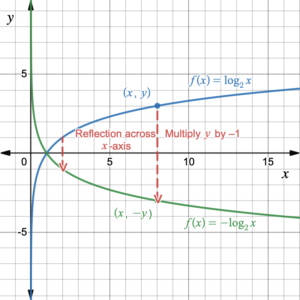
[latex]\dfrac{1}{8}[/latex]
-3
3
[latex]\dfrac{1}{4}[/latex]
-2
2
[latex]\dfrac{1}{2}[/latex]
-1
1
1
0
0
2
1
-1
4
2
-2
8
3
-3
Table 7. Reflecting the graph of [latex]f(x)=\log_2{x}[/latex] across the [latex]x[/latex]-axis transforms [latex]f(x)=\log_2{x}[/latex] into [latex]f(x)=-\log_2{x}[/latex].
Across the [latex]y[/latex]-axis
[latex]x[/latex]
[latex]-x[/latex]
[latex]\log_2{(-x)}[/latex]
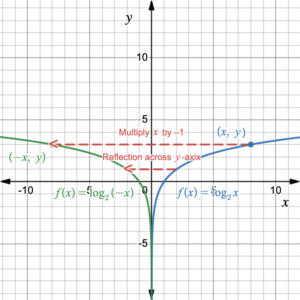
[latex]-\dfrac{1}{8}[/latex]
[latex]\dfrac{1}{8}[/latex]
–3
[latex]-\dfrac{1}{4}[/latex]
[latex]\dfrac{1}{4}[/latex]
–2
[latex]-\dfrac{1}{2}[/latex]
[latex]\dfrac{1}{2}[/latex]
–1
–1
1
0
–2
2
1
–4
4
2
–8
8
3
Table 8. Reflecting the graph of [latex]f(x)=\log_2{x}[/latex] across the [latex]y[/latex]-axis transforms [latex]f(x)=\log_2{x}[/latex] into [latex]f(x)=\log_2{(-x)}[/latex]
Example 6
- If [latex]f(x)=\log_3x[/latex] is reflected across the [latex]x[/latex]-axis what is the equation of the transformed function?
- If [latex]f(x)=\log_7x[/latex] is reflected across the [latex]y[/latex]-axis what is the equation of the transformed function?
- What transformation was made to the parent function [latex]f(x)=\log_5x[/latex] if the transformed function is [latex]f(x)=-\log_5{x}-6[/latex]?
- What transformation was made to the parent function [latex]f(x)=\log_2x[/latex] if the transformed function is [latex]f(x)=-3\log_2{-x}[/latex]?
Solution
- The [latex]y[/latex]-values change sign so the transformed function is [latex]f(x)=-\log_3x[/latex]
- The [latex]x[/latex]-values change sign so the transformed function is [latex]f(x)=\log_7{(-x)}[/latex]
- [latex]a=-1,\;k=-6[/latex] so the transformation was a reflection across the [latex]x[/latex]-axis and a shift down by 6 units
- [latex]a=-3[/latex] and [latex]x[/latex] is [latex]-x[/latex] so the transformation was a vertical stretch by a factor of 3, a reflection across the [latex]x[/latex], and a reflection across the [latex]y[/latex]-axis
Try It 6
- If [latex]f(x)=\log_9x[/latex] is reflected across the [latex]x[/latex]-axis what is the equation of the transformed function?
- If [latex]f(x)=\log_4x[/latex] is reflected across the [latex]y[/latex]-axis what is the equation of the transformed function?
- What transformation was made to the parent function [latex]f(x)=\log_5x[/latex] if the transformed function is [latex]f(x)=\log_5{(-x)}+4[/latex]?
- What transformation was made to the parent function [latex]f(x)=\log_2x[/latex] if the transformed function is [latex]f(x)=2\log_2{(-x)}[/latex]?
Combining Transformations
After learning all the transformations for the function [latex]f(x)=\log_b{x}[/latex], we should be able to write a transformed function given specific transformations, and also determine what transformations have been performed on the function [latex]f(x)=\log_b{x}[/latex], given an arbitrary transformed function [latex]f(x)=a\log_b{(x-h)}+k[/latex].
Example 7
What transformations have been done to the parent function [latex]f(x)=\log_2{x}[/latex] to get the transformed function [latex]f(x)=-3\log_2{(x+3)}-6[/latex]?
Solution
We need to identify [latex]a,\;h,\;k[/latex] and whether or not [latex]x[/latex] has a negative sign in front of it. To do this we line up the transformed function [latex]f(x)=-3\log_2{(x+3)}-6[/latex] with the standard function [latex]f(x)=a\log_2{(x-h)}+k[/latex]:
[latex]a=-3[/latex] means it has been stretched by a factor of 3 and reflected across the [latex]x[/latex]-axis.
[latex]h=-3[/latex] means it has been shifted left by 3 units.
[latex]k=-6[/latex] means it has been shifted down by 6 units.
Try It 7
- What transformation was made to the parent function [latex]f(x)=\log_5x[/latex] if the transformed function is [latex]f(x)=\log_5{-x}+7[/latex]?
- What transformation was made to the parent function [latex]f(x)=\log_2x[/latex] if the transformed function is [latex]f(x)=-2\log_2{(x-5)}-4[/latex]?
Example 8
- If [latex]f(x)=\log_3x[/latex] is reflected across the [latex]x[/latex]-axis, stretched by a factor of 3, and shifted left by 2 units, what is the equation of the transformed function? What happens to the vertical asymptote?
- If [latex]f(x)=\log_7x[/latex] is reflected across the [latex]y[/latex]-axis, compressed to half its height, and shifted up by 7 units, what is the equation of the transformed function? What happens to the vertical asymptote?
Solution
- [latex]a=-3,\;h=-2[/latex] so the transformed function is [latex]-3\log_3{(x+2)}[/latex]. The vertical asymptote is shifted left by 2 units from [latex]x=0[/latex] to [latex]x=-2[/latex].
- [latex]a=\frac{1}{2},\;k=7[/latex] and [latex]x[/latex] has a negative coefficient so the transformed function is [latex]f(x)=\frac{1}{2}\log_7{(-x)}+7[/latex]. Since there are no horizontal shifts, nothing happens to the vertical asymptote.
Try It 8
- If [latex]f(x)=\log_3x[/latex] is stretched by a factor of 7, shifted right by 4 units and shifted down by 4 units, what is the equation of the transformed function? What happens to the vertical asymptote?
- If [latex]f(x)=\log_7x[/latex] is reflected across the [latex]x[/latex]-axis, compressed to one-sixth its height, shifted left by 1 unit, and shifted up by 7 units, what is the equation of the transformed function? What happens to the vertical asymptote?
Move the red dots in manipulation 5 to change the values of [latex]a, h, k[/latex] and [latex]b[/latex] or to reflect the graph across the [latex]y[/latex]-axis. Pay attention to what happens to the graph and the relationship between the values of [latex]a,\;h,\;k[/latex] and the transformed function.
Manipulation 5. Transformations on [latex]f(x)=\log_b{x}[/latex]
Candela Citations
- Transformations of the logarithmic function f(x)=log_b{x}. Authored by: Leo Chang and Hazel McKenna. Provided by: Utah Valley University. License: CC BY: Attribution
- All graphs created using desmos graphing calculator. Authored by: Leo Chang. Provided by: Utah Valley University. Located at: http://www.desmos.com/calculator. License: CC BY: Attribution
- All Examples and Try Its: hjm624; hjm832; hjm302; 442; hjm356; hjm098; hjm529; hjm831. Authored by: Hazel McKenna. Provided by: Utah Valley University. License: CC BY: Attribution
- All manipulations created using Desmos. Authored by: Hazel McKenna. Provided by: Utah Valley University. Located at: http://desmos.com. License: CC BY: Attribution
